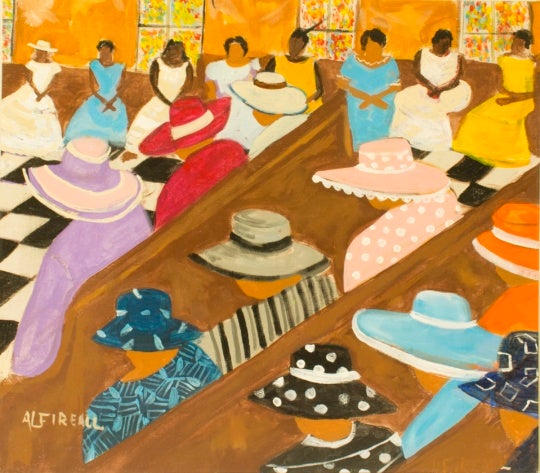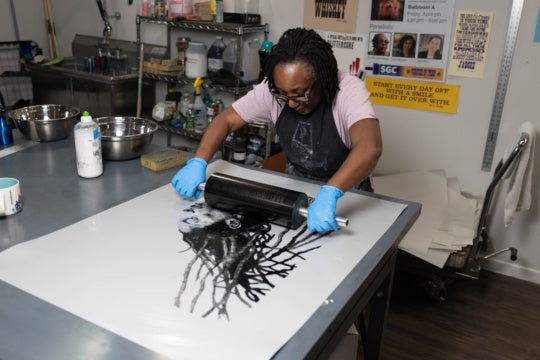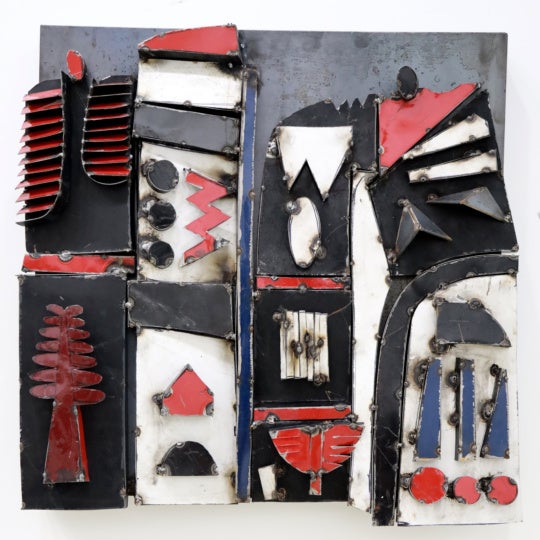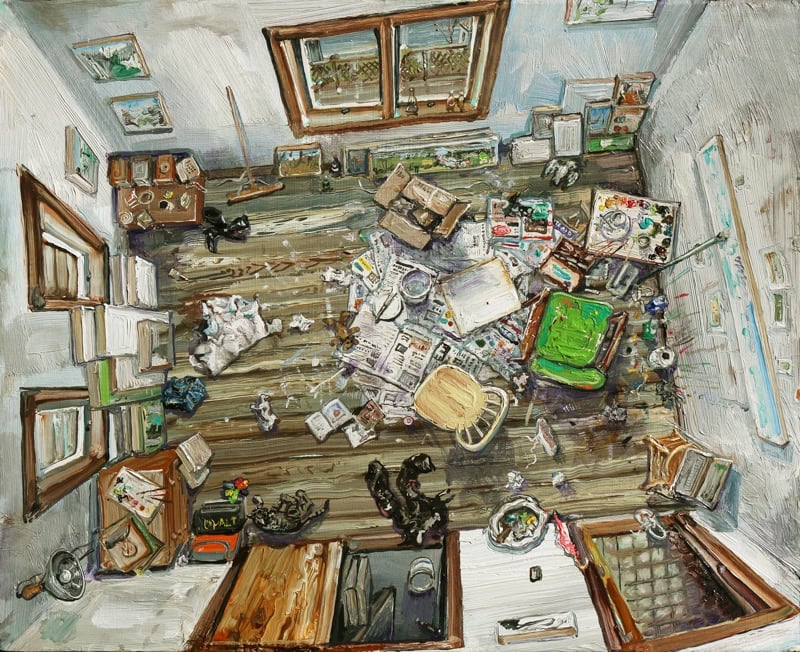
Residence, transience, environment, and the certain temporality that affects us all are explored in Amer Kobaslija’s latest exhibit, “A Sense of Place.” A collection of 33 paintings that range from miniature to large scale, Kobaslija’s show turns UNF Gallery at Museum of Contemporary Art Jacksonville (MOCA JAX) into a winding rumination on those concepts layered onto still life environments that toggle the mundane with the mystical.
Kobaslija’s ongoing attempts at capturing interior states and exterior settings could arguably be pointed back to his early life as both political exile and refugee. Born in 1975 in Bosnia, Kobaslija fled the war-ravaged country 18 years later. His family found refuge in Germany in 1993, eventually moving to Jacksonville, Florida in 1997. Kobaslija garnered a BFA in printmaking at Ringling College of Art & Design in Sarasota, followed by a MFA from New Jersey’s Montclair State University. It was during this flurry of academic study that he seemed to have discovered a methodology based on closure, intimacy, and the subtle forces of familiarity, collectively opening the parameters of his work.
“I’d started painting interiors when I was a graduate student at Montclair State twelve years ago. Prior to that I had dealt with memories in my work, always looking back in time. Being an immigrant and a war refugee, through my art I was trying to make sense of what had happened in Bosnia,” says Kobaslija. “By the time I entered graduate school at Montclair, I felt ready to leave the past behind and embrace the present – not just look but also see it, and deal with it through the act of painting. And there it was, my tiny studio provided by the university, a cell-like room for me to study and paint in it. At first with little understanding of what I was doing, I intently looked at that clattered space and everything in it – and then painted it all with a great deal of care. And there I had my first studio painting completed; which I liked to the point of proceeding to paint a second one. Eventually, I began to recognize that by painting my immediate surroundings I was creating allegorical self-portraits.”

The piece Before the Deluge exemplifies Kobaslija’s mastery of creating a memoir through a maelstrom of objects found in a studio. Utilizing a type of spiraling compositional placement, routine painter equipment materials such as canvases, lights, tattered furniture, and paints and peppered with more personalized objects like shoes, a teddy bear, and a black cat resting in this almost-comforting chaos.
“I am not directly described in those paintings yet I am fully revealed. I liked the idea of dealing with self without the necessity of painting one’s own likeness, and so I have continued to work on my studio painting series,” offers Kobaslija. “Some painters paint themselves as they age; I paint my studios.”
Other works in the show such as Painter’s Floor (Jackson Pollock, East Hampton) and Spirit of Place (Balthus, Rossinière) are meditations on the works of some of Kobaslija’s heroes, pilgrimages that he memorializes in his signature autobio-narrative style, rendered in thick, muscular strokes and swirls of oils, celebrating two creative enclaves of 20th-century masters that are, to some inviolable, if not sacred.
“A Sense of Place” also displays Kobaslija’s acknowledgement of both the sometimes-arbitrary holiness and horror of nature. A series of works created in the aftermath of the 2011 earthquake and tsunami that brutalized Kesennuma, Japan are blunt counterparts to the artist’s reflective, interior pieces. Black Smoke No. 6 offers up a baleful vision of a destroyed port, ships strewn angrily across a now-graveyard of vacant buildings, a fiery column of black smoke gloating over the wasteland below. Conversely, Ichetucknee, Midpoint is a tender four-color wash snapshot of the central north Florida river, rendered in a style that reveals Kobaslija’s love of the Ukiyo-e printmakers of the 17th-century Edo period.
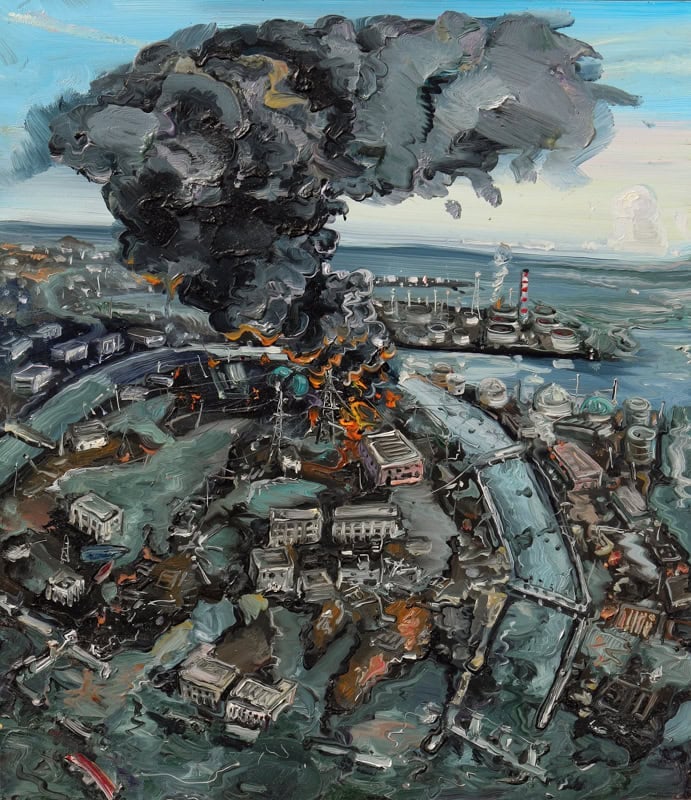
In the past decade, Kobaslija has been heavily recognized for his efforts at chronicling his inner journeys that occur while documenting the outer word. A Joan Mitchell Foundation Grant (2005), Pollock-Krasner Foundation Grant (2006), and John Simon Guggenheim Memorial Fellowship (2013) are but a few cultural awards he has received. For more than a decade, he’s been represented by New York’s esteemed George Adams Gallery. In addition, Kobaslija is an instructor at Pennsylvania’s Gettysburg College.
Yet focusing on these impressive credentials seem to come secondary for Kobaslija, an artist whose measured and unique approach spiritually “upcycles” sometimes otherwise staid styles – still life and naturalism. And that is the place where Kobaslija is truly leaving his mark in the art world.
“That’s what this is really about: this idea of mark-making, literally and metaphorically speaking. Man has an innate urge to contribute to the world he inhabits,” says Kobaslija. “We insist on leaving something behind – a clue or a record that we were here, that we existed – for future generations. We write our diaries.”

